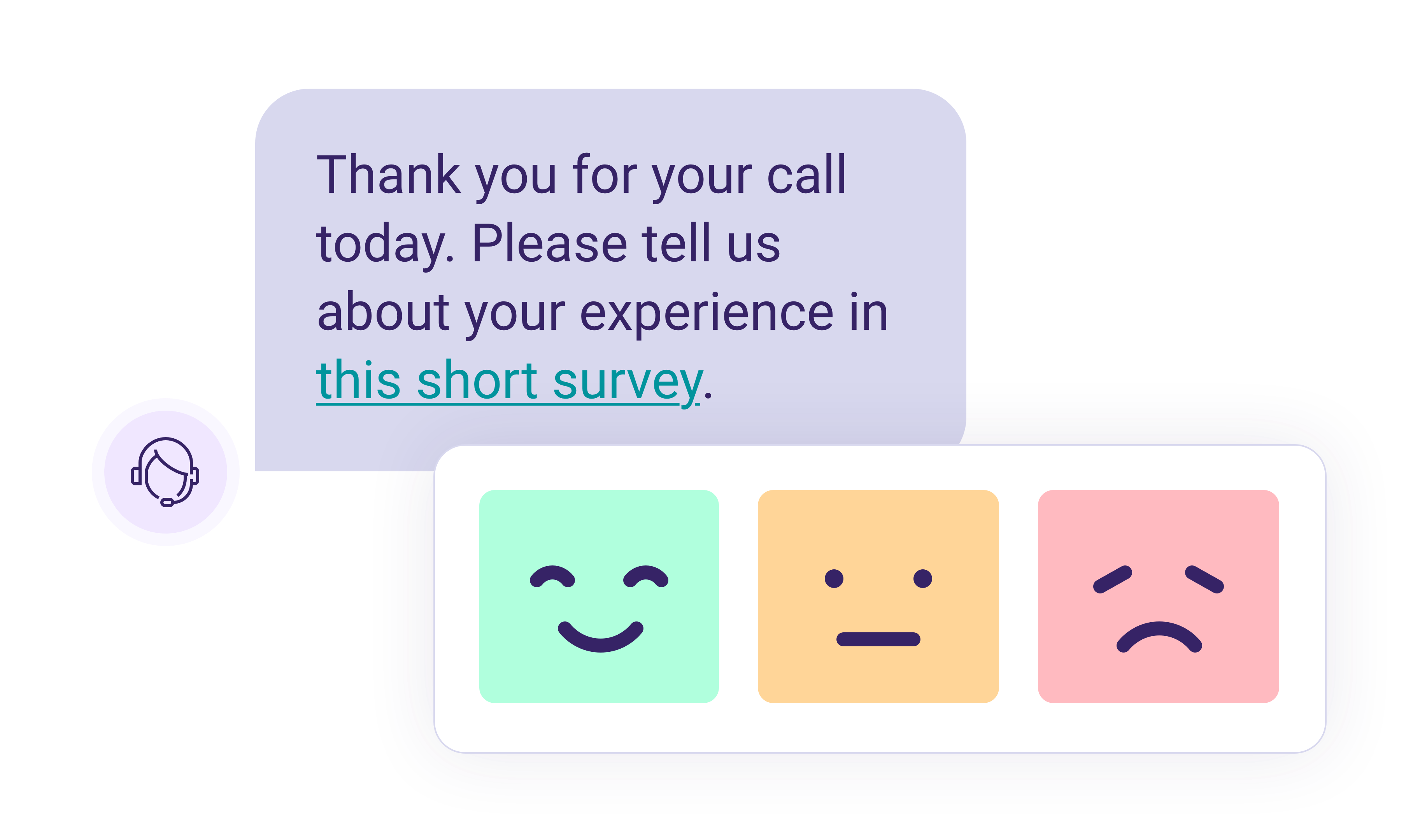SMS is quickly becoming the hot channel for customer communication because text is faster than email or phone, and customers want quick responses in their preferred channel—lack of speed is the third-largest pain point with customer service frustration, and 52% of customers prefer text over their current form of communication.
You have to start your SMS customer service text messaging strategy with a real concern for the customer, along with a desire to find them in their channel and address their concerns there. More than 85% of customers expect conversations with agents to move seamlessly and in real time between channels without repeating their problems. Once that’s established, this will lead to greater customer satisfaction, and therefore higher CSAT scores. According to a McKinsey report, going through a customer’s journey and maximizing their satisfaction not only increases customer satisfaction by 20%, but also lifts revenue by up to 15%.
Here are some examples for CX teams that are sending texts as part of their support strategy. These examples are great if you need some suggestions or are looking for ideas to implement automatic replies for chatbot operations.
Examples of problem-resolution texts
When a customer reaches out to your company looking for support, it’s an issue they want resolved immediately. The top issues customers contacted customer support for are delivery of a product (17%) or requesting info on a product (10%).
Great of customer support resolution texts that are simple, concise, polite, and personalized—all qualities that make a good customer service text.
Examples of problem-resolution texts:
- Hi [customer name], thanks for contacting us. We understand there may be a problem with your order. We’re looking into it right now, and we’ll get back to you as soon as we find out what’s going on.
- Hi [customer name], I just received your ticket. What can I help you with today?
- Hi [customer name], If I understand correctly, you had XYZ go wrong with your order. Let’s try to clear that up for you right now!
Examples of survey feedback texts
Surveys conducted through text will gather responses much faster than email, and you’re going to get more people responding.
Research shows that SMS open rates are as high as 98%, compared to just 20% of all emails. And, on average, it takes 90 seconds for someone to respond to a text and 90 minutes to respond to an email. Also, text messages have a 45% response rate, whereas email responses are just at 8%, so you‘ll get more responses as well.
Text surveys can also be iterative—you don’t have to force a customer to fill out a 10-minute survey all up front. You can request a text response to rate the service, and then send them a link to a longer survey. Now you have the immediate CSAT data, and can gain addition survey insights from customers willing to commit to longer questioning.
Examples of survey feedback text messages:
- Hi [customer name], thank you for your recent purchase! We hope you love it! To help us better serve customers like you in the future, would you help us with a short survey? On a scale of 1-10 (10 being best), how would you rate us? To leave your feedback, just reply with a #.
- Hello [customer name], we see that you recently contacted customer support about [ticket category]. Could you take a minute to help us improve our service by answering these short survey questions? It should only take about three minutes of your time.
Examples of a text that transitions to voice
We all know customers hate being transferred and starting a support ticket from scratch—33% of customers say it’s the most frustrating aspect of customer service. You should aim for a way to transition a customer to other agents or departments with the full dossier of their issue already at hand. One way is to start with a text, then use that text to transition the customer to a live chat agent.
Start the text chat with a personalized note:
- Hi [customer name], thanks for contacting customer support. What can we help you with today?
When the customer informs you of what they need, make a determination of whether or not the issue needs a resolution to a live agent. Then text the customer back and let them know you’re sending them to escalated support:
- Based on your issue, we think a specialist can solve your problem on the phone. Would you like us to call you as soon as possible, or would you like to schedule a call?
At this point, a tool like Mindful can help by scheduling the callback for whenever is most convenient for the customer.
Examples of a support text to bring back customers
Losing a customer is rarely a good thing for a business. But a customer who has lapsed or who hasn’t looked up your brand in a while doesn’t mean they’re a write-off. First, find out why they left. Then, send them a quick email to let them know their problem was fixed.
For example, if customer service was a problem in the past, a text like this helps:
- Hi [customer name], we heard you’ve had issues with our customer service—and with great feedback from customers like you, we changed it! Come back and check out all the improvements by texting back, or drop by our website [URL].
Or, if there were complaints about long wait times:
- We know time is precious—which is why we’re not wasting any more of yours! Call in today and experience our new scheduled callback service that gives you free time instead of wait time.
The most effective customer support email, however, has an incentive attached to it:
- Thanks for reaching out to our team. We know we not have met your expectations, so here’s XX% off your next order. It doesn’t fix everything, but we hope it shows our appreciation for you!
Examples of follow up texts
A follow-up text shows concern. Customers want to feel you’re staying with them through the whole journey, including after the sale. Follow-up texts also have the ability to gauge future interest in your product or brand and generate leads.
Here are a few examples of follow up texts that let the customer know you still care:
- Hi [customer name], you purchased [product name] a couple of weeks ago. We were wondering, how much are you loving it? If you’re not, we want to know that too! Just text back or call this number.
- Hi [customer name], you’re probably really busy enjoying [product name]. Is there anything we can do for you to help you enjoy it? The whole team is wondering how you like it. Text us back at this number and let us know!
- You called us on [ticket date] about the issue with [ticket category]? We’re checking in to see if you’re still having issues. Just text back to let us know!
Important texting tips for SMS communications
Here are a few basic rules to think about as you’re writing text messages to help your customer. These should ultimately help your business communicate more effectively.
1. Write short, simple texts.
Today’s customer doesn’t have a lot of time. They prefer short, simple texts as opposed to lengthy emails, which is why the open rate for texts is as high as 98%, while emails are only read 20% of the time. When you want to get your message across and only have a limited amount of characters to spare, you have to be frugal with your wording.
Most text services cap at 160 characters. A good practice is to highlight one-two key points, and include a call to action. Save long messages for emails— keep texts short and focused.
If the text thread becomes complicated, offer a clear and easy way for the customer to request a call from your team.
2. Show empathy by creating the right tone in your message.
The tone in messages is the way in which you talk to your customers. If your texts are terse and robotic, customers may be irritated. Conversely, if the tone in texts is too humorous or lighthearted, and your customer has a serious inquiry, your texts may come across as glib or inappropriate.
Empathy is key. In a recent report from Genesys, empathy ranked first for what a customer is looking for when seeking support—higher than speed or personalization.
Empathy statements have to start with really caring about how the customer is feeling on their call. Fake it, and you could wind up with a customer who doesn’t trust you. Nail it, and you have a customer who will feel appreciated and remain loyal to your brand. Harvard Business Review research suggests the top 10 most empathetic companies gained more than twice as much as the bottom 10 companies and generated 50% more earnings.
Some examples of empathy statements:
- “I know how inconvenient this is.
- Thank you for getting in touch with us about this issue.
- I would feel the same way in that situation.
Another common empathy tool—repeat the issue to the customer and ask, ”If I understand you correctly, your issue is XYZ?“ This gives the customer the opportunity to restate the issue if you have it wrong or confirm to the customer you’re paying attention and you know exactly what they need.
3. Make sure your business texts match your brand.
When the experience doesn’t match the company, it creates mistrust in customers. For instance, short, humorous texts from a financial institution don’t just raise an eye—some customers ignore the text completely because they don’t believe them.
What your brand stands for should be the guideline for the tone of your texts. According to a 2021 SMS Marketing Consumer Trends Report, almost 67% of consumers sign up for texts from their favorite brands. And Shift Communications reports that 82% of people open every text they receive from a brand.
Brand signaling includes:
- Align your promotions and calls to action with the brand vision and values.
- Match the tone of the text with the tone of the brand.
- Restate what your company stands for in the introduction to your texts (e.g. “we know healthier habits start at home” for an organic retailer).
4. Make any transition seamless and intuitive.
There will come a time when a customer service text message won’t suffice. It’s unavoidable. But there are key features that set one brand apart from another when it comes to this moment in the journey.
- Offer a call directly from the text instead of asking them to dial a phone number. If the customer has already spent time texting your brand, they may not have time to call into your contact center right then. Give the customer a chance to schedule a callback in the text thread or even online so it’s convenient for them and trackable for your brand.
- Call and text from the same company phone number. The last thing you want is the customer to ignore your call when it’s time to move from text to voice. Call from the same phone number to build trust in your brand. Can’t facilitate that consistency? Mindful can help.
- Use text notifications after a call is scheduled. Once the customer decides to transition to voice, send them text notifications to confirm their call and remind them of the upcoming call. You know they already prefer the text channel, so these notifications will be welcomed reminders to keep them on track.
Summing up
Time is a commodity that affects all corners of your business and the customer’s experience. You don’t want to waste it, and you don’t want to spend it on minor issues that can be resolved with automated text bots. Make your customer’s experience a better one (and see a jump in your CSAT scores as a result) when you use text messaging effectively. Start with these examples to create your own template of service responses.






